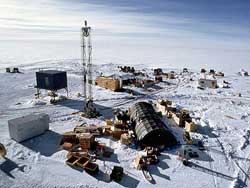This area deals with the fundamental laws and building blocks of nature and how they interact, the properties and the behavior of matter, and research into space and time and their structures.
innovations-report provides in-depth reports and articles on subjects such as astrophysics, laser technologies, nuclear, quantum, particle and solid-state physics, nanotechnologies, planetary research and findings (Mars, Venus) and developments related to the Hubble Telescope.

Solar Physicists at the Mullard Space Science Laboratory, University College London (MSSL-UCL) have discovered new clues to understanding explosions on the Sun.
Coronal mass ejections are violent explosions that can fling electrified gas [plasma] with a mass greater than Mount Everest towards the Earth with destructive consequences for satellites. They can originate from active regions on the Sun, long known to consist of forests of loops filled with plasma. These active loops are roughly 5

What goes on inside the heart of a star? Astronomers have been developing theories about stars’ inner workings for decades, but evidence to confirm the details of those theories has been sparse.
In research supported by NSF, University of Arizona astronomer Elizabeth Green and colleagues have found a new subset of “nearly-naked” stars that dim and brighten due to pulses in their cores. The stars, which may help unlock secrets of advanced stages of stellar evolution, are described in th

In recent years, scientists have discovered that the iridescence of various colorful creatures, from beetles to birds to butterflies, is often due to microscopic structures known as photonic crystals. Unlike pigments, which absorb or reflect certain frequencies of light as a result of their chemical composition, the way that photonic crystals reflect light is a function of their physical structure. That is, a material containing a periodic array of holes or bumps of a certain size may reflect blue

Researchers can now pinpoint direction of elusive subatomic particles key to understanding black holes, other cosmic events
A unique telescope buried in Antarctic ice promises unparalleled insight into such extraordinary phenomena as colliding black holes, gamma-ray bursts, the violent cores of distant galaxies and the wreckage of exploded stars.
An international team of physicists and astronomers, which includes UC Irvine researchers, report that the AMANDA telescope is cap

Nothing travels faster than light – it only takes 8 minutes for it to reach the Earth from the nearest star, the Sun, which is 150 million kilometres away. Now anyone can measure this speed – with chocolate stars and a microwave oven! The experiment is described on a new Institute of Physics web resource for teachers about fun physics demonstrations, inspired by the Physics on Stage 2 event.
The only equipment you need for this experiment is a microwave, a ruler and chocolate, cheese or any

Somewhere in the distant, old Universe, a population of stars hide undetected. They were the first to form after the birth of the Universe and are supposed to be far bigger in mass than any star visible today.
Astronomers know they must have been out there: only in this way could they solve the riddle of the origin and composition of stars in today’s Universe. A couple of ESA missions will help astronomers search for this elusive population.
When the Universe formed, there was